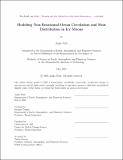Modeling Non-Rotational Ocean Circulation and Heat Distribution in Icy Moons
Author(s)
Nath, Anika
DownloadThesis PDF (898.6Kb)
Advisor
Teague, Richard
Hill, Christopher N.
Terms of use
Metadata
Show full item recordAbstract
Subsurface oceans beneath the ice shells of icy moons like Europa and Enceladus are considered promising environments for extraterrestrial life. Their long-term habitability depends on internal heating and efficient vertical heat transport to maintain liquid water beneath the surface. This study models vertical heat diffusion in a non-rotating ocean column to investigate thermal structure and energy balance in such systems. A one-dimensional numerical simulation was developed using temperature-dependent thermal conductivity and fixed Dirichlet boundary conditions, initialized with a linear temperature gradient from −10 K at the surface to +10 K at the base. Over 1000 time steps, the temperature profile became nonlinear, with a kink indicating the transition from ice to water. Despite fixed boundary temperatures, the interior warmed, and the average temperature rose to 2.84 K. This resulted from asymmetric conductivity: efficient heating from below and slow heat loss through the upper ice. These results illustrate how conductivity structure controls thermal evolution and ice shell stability on ocean worlds.
Date issued
2025-05Department
Massachusetts Institute of Technology. Department of Earth, Atmospheric, and Planetary SciencesPublisher
Massachusetts Institute of Technology